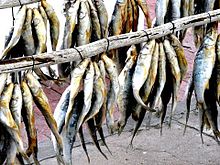Bokkoms

Bokkoms
|
|
| Place of origin | South Africa |
|---|---|
| |
|
Bokkoms (or Bokkems) is whole, salted and dried mullet (more specifically the Southern mullet, Liza richardsonii, a type of fish commonly known in the Western Cape of South Africa as "harders"), and is a well-known delicacy from the West Coast region of South Africa. This salted fish is dried in the sun and wind and is eaten after peeling off the skin. In some cases it is also smoked. It is sometimes referred to as "fish biltong".
The word bokkom comes from the Dutch word bokkem, which is a variant of the word bokking (or buckinc in Middle Dutch). The word bokking is derived from the word bok (the Dutch word for buck or goat), and refers to the fact that bokkoms reminds of goat, because bokkoms has the same shape as the horns of a goat, it is just as hard as a goat's horns, and it stinks just as much as the horn of a goat (goats have scent glands behind their horns which causes the smell). The first official record of the use of the word in the Afrikaans language of South Africa was in the Patriotwoordeboek in 1902 in the form bokkom.
As early as 1658, only six years after the first permanent settlement of Europeans at the Cape of Good Hope, four free burghers were given permission to settle in Saldanha Bay on the West Coast of Southern Africa. They were given the right from the Dutch East Indian Company to fish the waters of Saldanha Bay and send their catches to the Company's trading post at the Cape of Good Hope to be sold to other burghers as well as to passing ships in Table Bay. They had sole rights to the lucrative fishing until 1711. One fifth of the catch had to be delivered in salted and dried form, which was the origins of bokkoms in South Africa.
The ingredients for bokkoms consists of small (juvenile) mullet (fish), coarse salt and fresh water. The original West Coast way of preparing bokkoms starts with catching the small (juvenile) mullets (called "harders" in Afrikaans). A large square tank built out of bricks or stone is filled with a strong pickle made of around 50 kg of coarse salt and fresh water, to which the fish is added. As soon as enough fish is added to reach the top of the tank, two or three spades full of dry coarse salt is spread on top of the fish. Thereafter more layers of fish and salt is put on top until all the fish is covered in salt. A thick layer of salt is added to the top. This is left for one day. On the second day, a press made with wood with weights on top, is placed on the fish in the tank. The purpose of the press is to ensure that the guts of the fish is pressed flat so that it does not go bad. After the third day in the tank, the fish is taken out and is then stringed up in bunches of 10 to 25 fish each on a rope, making use of a fish needle which is pushed through the eyes of the fish. The bunches are then dipped 2 to 3 times in fresh water, before it is hung on scaffolds to dry.
...
Wikipedia
